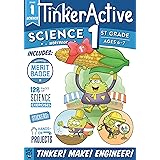As children begin their educational journey in the first grade, the importance of making learning enjoyable cannot be overstated. Engaging workbooks serve as a valuable tool in achieving this goal. They not only reinforce essential skills but also stimulate creativity, critical thinking, and a love for learning. This article delves into the significance of engaging workbooks for 1st graders, explores various strategies for their design, and highlights real-world examples and research that underscore their effectiveness.
The Importance of Engagement in Learning

Engagement is a critical factor in the learning process, especially for young children. Research shows that when children are actively engaged in their learning, they are more likely to retain information and develop a positive attitude toward education. According to a study published in the Journal of Educational Psychology, students who feel engaged in their learning are 50% more likely to demonstrate improvement in academic performance compared to their disengaged peers.
For 1st graders, engagement can be fostered through a variety of methods, with interactive workbooks being one of the most effective. These workbooks not only make learning fun but also cater to different learning styles, ensuring that every child can find a method that resonates with them.
Characteristics of Engaging Workbooks

To create workbooks that captivate young learners, certain characteristics must be incorporated:
- Colorful and Appealing Design: Bright colors and engaging illustrations can capture a child’s attention and make the learning experience more enjoyable.
- Interactive Elements: Including puzzles, mazes, and games encourages active participation rather than passive reading.
- Real-Life Context: Situating learning in real-world scenarios helps children understand the relevance of what they are learning.
- Diverse Activities: A mix of worksheets, art projects, and hands-on activities caters to different learning styles and keeps the content fresh.
- Clear Instructions: Simple, concise directions help children navigate through the activities independently, fostering confidence.
Types of Engaging Activities for 1st Graders

When designing workbooks for 1st graders, incorporating a variety of activities can make learning more enjoyable. Here are some examples:
- Storytelling and Creative Writing: Exercises that encourage children to create their own stories or continue a story can stimulate imagination and improve literacy skills.
- Math Games: Fun math-related puzzles or games, such as Sudoku or bingo, can help solidify basic math concepts while making learning enjoyable.
- Art Integration: Activities that require drawing or coloring can enhance fine motor skills and make subjects like science or history more relatable.
- Interactive Reading Comprehension: Incorporating questions and activities related to a story can help improve comprehension and critical thinking.
- Hands-On Science Experiments: Simple experiments that can be done at home or in the classroom can make science tangible and exciting.
Case Studies: Successful Implementations

Several schools and educators have successfully implemented engaging workbooks into their curricula, yielding positive outcomes.
One notable example comes from a school district in California, where teachers introduced interactive workbooks as a supplementary resource for their 1st-grade curriculum. The results were remarkable:
- Improved Engagement: Teachers reported that students were more eager to participate in classroom activities and discussions.
- Higher Test Scores: Standardized test scores in literacy and math increased by an average of 15% over the academic year.
- Positive Feedback from Parents: Parents noted that their children were excited about doing homework and often asked to work on their workbooks during family time.
This case study highlights the potential of engaging workbooks to enhance educational experiences for young learners. Similarly, a study conducted by the National Center for Learning Disabilities found that students who used interactive learning materials showed a 20% increase in retention rates compared to those who used traditional textbooks.
Incorporating Technology into Workbooks

In today’s digital age, integrating technology into traditional workbooks can further enhance engagement. Digital workbooks that include interactive features such as videos, audio readings, and interactive quizzes can cater to tech-savvy young learners.
- Interactive Apps: Some companies have developed apps that complement physical workbooks, allowing children to engage with the material in various formats.
- Online Portfolios: Digital platforms where students can submit their work can foster a sense of accomplishment and allow for peer feedback.
- Gamification: Utilizing game mechanics in learning, such as rewards and points for completing tasks, can motivate students to engage more deeply with the content.
Tips for Parents and Educators

Parents and educators play a crucial role in leveraging engaging workbooks to enhance learning. Here are some tips for maximizing their effectiveness:
- Create a Routine: Establish a regular time for workbook activities to help children develop a consistent learning habit.
- Encourage Collaboration: Promote group work or buddy systems where students can share ideas and learn from each other.
- Provide Positive Reinforcement: Celebrate milestones and achievements to motivate children to keep learning.
- Incorporate Play: Blend learning with play by using games and activities that reinforce workbook material.
- Seek Feedback: Ask children about their favorite activities and what they enjoy to tailor the learning experience further.
Engaging workbooks are a powerful tool in making learning fun for 1st graders. By incorporating colorful designs, interactive activities, and real-life contexts, these workbooks not only enhance engagement but also foster a love for learning that can last a lifetime. The evidence from case studies and research supports the effectiveness of these materials in improving academic performance and student motivation.
As we continue to adapt our teaching methods to meet the needs of young learners, it is essential to embrace innovative approaches that make learning enjoyable. With the right strategies and resources, educators and parents can create enriching educational experiences that ignite curiosity and inspire a lifelong passion for learning in children.